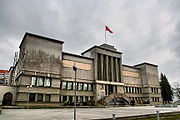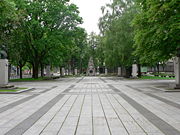
Vytautas the Great War Museum
Encyclopedia

Kaunas
Kaunas is the second-largest city in Lithuania and has historically been a leading centre of Lithuanian economic, academic, and cultural life. Kaunas was the biggest city and the center of a powiat in Trakai Voivodeship of the Grand Duchy of Lithuania since 1413. During Russian Empire occupation...
, Lithuania
Lithuania
Lithuania , officially the Republic of Lithuania is a country in Northern Europe, the biggest of the three Baltic states. It is situated along the southeastern shore of the Baltic Sea, whereby to the west lie Sweden and Denmark...
. It was opened on 16 February 1936 and named after Vytautas the Great, Grand Duke of Lithuania. The museum displays historical artefacts pertaining to Lithuania and Kaunas from prehistoric times to the present day, including a large collection of historical weapons. There are expositions dedicated to the military skills of the Grand Duchy of Lithuania
Grand Duchy of Lithuania
The Grand Duchy of Lithuania was a European state from the 12th /13th century until 1569 and then as a constituent part of Polish-Lithuanian Commonwealth until 1791 when Constitution of May 3, 1791 abolished it in favor of unitary state. It was founded by the Lithuanians, one of the polytheistic...
, Vytautas the Great Chapel, collections of weapons, firearms, ammunition, army uniforms of various states, defense of the Kaunas Fortress
Kaunas Fortress
Kaunas Fortress is the remains of a fortress complex in Kaunas, Lithuania. It was constructed and renovated between 1882 and 1915 to protect the Russian Empire's western borders, and was designated a "first-class" fortress in 1887...
in 1915, and others. The airplane Lituanica
Lituanica
Lituanica was an Bellanca CH-300 Pacemaker airplane flown from the United States across the Atlantic Ocean by Lithuanian-American pilots Steponas Darius and Stasys Girėnas in 1933...
, on which Steponas Darius
Steponas Darius
Steponas Darius was a Lithuanian-American pilot....
and Stasys Girėnas
Stasys Girenas
Stasys Girėnas was a Lithuanian-American pilot....
flew across the Atlantic Ocean
Atlantic Ocean
The Atlantic Ocean is the second-largest of the world's oceanic divisions. With a total area of about , it covers approximately 20% of the Earth's surface and about 26% of its water surface area...
in 1933, is on display and remains a popular exhibition.
In the great hall of the museum there are copies of the 17th century cannon
Cannon
A cannon is any piece of artillery that uses gunpowder or other usually explosive-based propellents to launch a projectile. Cannon vary in caliber, range, mobility, rate of fire, angle of fire, and firepower; different forms of cannon combine and balance these attributes in varying degrees,...
s. Especially large the is a comprehenseve collection of the 18th century pistol
Pistol
When distinguished as a subset of handguns, a pistol is a handgun with a chamber that is integral with the barrel, as opposed to a revolver, wherein the chamber is separate from the barrel as a revolving cylinder. Typically, pistols have an effective range of about 100 feet.-History:The pistol...
s.

Tomb of the Unknown Soldier
Tomb of the Unknown Soldier refers to a grave in which the unidentifiable remains of a soldier are interred. Such tombs can be found in many nations and are usually high-profile national monuments. Throughout history, many soldiers have died in wars without their remains being identified...
and eternal flame
Eternal flame
An eternal flame is a flame or torch that burns day and night for an indefinite period. The flame that burned constantly at Delphi was an archaic feature, "alien to the ordinary Greek temple"....
, are located in the square in front of the museum. During the time of the First Lithuanian Republic (1918–1940), when Kaunas was the temporary capital of Lithuania
Temporary capital of Lithuania
The temporary capital of Lithuania was the official designation of the city of Kaunas in Lithuania during the interwar period. It was in contrast to the declared capital in Vilnius , which was under Polish control from 1920 until 1939...
, national holidays were celebrated in the square. The plaque commemorating book smugglers and distributors Knygnešių sienelė is also situated alongside.
The Kaunas 35-bell carillon
Carillon
A carillon is a musical instrument that is typically housed in a free-standing bell tower, or the belfry of a church or other municipal building. The instrument consists of at least 23 cast bronze, cup-shaped bells, which are played serially to play a melody, or sounded together to play a chord...
(range from as1 to as4) in the tower of the Vytautas the Great War Museum was completed in Belgium
Belgium
Belgium , officially the Kingdom of Belgium, is a federal state in Western Europe. It is a founding member of the European Union and hosts the EU's headquarters, and those of several other major international organisations such as NATO.Belgium is also a member of, or affiliated to, many...
in 1935. Bell music from the tower was first played in 1937. Regular carillon concerts began in 1956. The first carillonists of the Kaunas carillon were Lithuanian composers Viktoras Kuprevičius and his son Giedrius Kuprevičius. The carillon was restored by the Royal Eijsbouts bell foundry in Asten
Asten
Asten is a municipality and a town in the southern Netherlands.It is home to the Royal Eijsbouts bell foundry and also a carillon museum.- History :...
, Netherlands
Netherlands
The Netherlands is a constituent country of the Kingdom of the Netherlands, located mainly in North-West Europe and with several islands in the Caribbean. Mainland Netherlands borders the North Sea to the north and west, Belgium to the south, and Germany to the east, and shares maritime borders...
, in 2005-2006. After the restoration, the carillon has 49 bells and a new keyboard. Every day at midday, the Lithuanian war time song Oi, neverk motušėle is played.
The crypt
Crypt
In architecture, a crypt is a stone chamber or vault beneath the floor of a burial vault possibly containing sarcophagi, coffins or relics....
to Those Perished for the Freedom of Lithuania was constructed in 1938. The crypt was vandalized and destroyed during the time of Soviet occupation
Baltic states under Soviet rule (1944–1991)
The Baltic states under Soviet rule covers the period from the end of World War II in 1945, stretching from the sovietization to regaining the independence in 1991. The Baltic states were incorporated to the Soviet Union into the 1940 annexation as the Soviet socialist republics of Estonia, Latvia...
. After the restoration the crypt inside covered with black marble was opened again in 1998.
The museum shares its building with the M. K. Čiurlionis National Art Museum
M. K. Ciurlionis National Art Museum
The M. K. Čiurlionis National Art Museum is a group of museums based in Kaunas, Lithuania. It is primarily dedicated to exhibiting and publicizing the works of the painter and musician M.K. Čiurlionis ....
and is located in Vienybė Square. The museum and its surroundings are depicted on the 20 litas banknote
Banknotes of the Lithuanian litas
The modern banknotes of Lithuania are denominated in litas. All banknotes are of the same size except for the 500 litų banknote. They bear signatures of Minister of Finance and of Chairperson of the Bank of Lithuania Board. 10, 20, and 50 litų banknotes have 4 releases...
.
Photographing is forbidden in the museum (2010).

